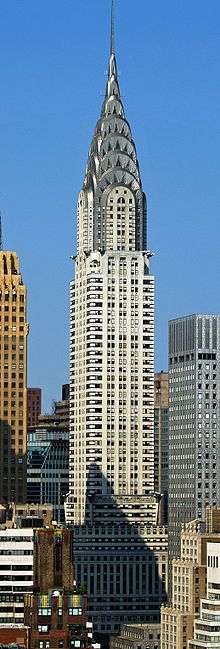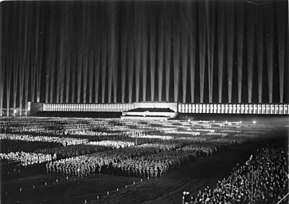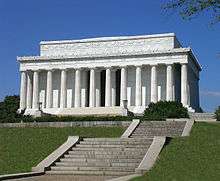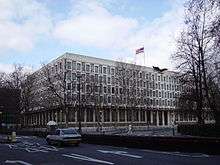Architectural propaganda
Architectural propaganda is the use of architecture, intentionally or unintentionally, to communicate an attitude or idea in a persuasive manner, often for an explicitly propagandistic purpose. The use of architecture for propaganda purposes in order to influence attitudes, opinions, and feelings of the target audience can be found in many cultures across history. Since architecture itself is an expression of culture, the propaganda element of architecture can organically flow from the structure by nature of its being.
The fact that something may be used for propaganda is not a values statement about the thing itself. It is a simple truism that people are influenced by things around them and therefore, when those things around include architecture, people will be influenced by it as a part of an environment. This inherent quality of architecture then can be used by those with the desire to do so. This use is what transforms the architecture from a simple influence into a piece of propaganda.
The psychological dimension of architecture and propaganda means that even when a group or government has no direct intent to use architecture for propaganda purposes, the nature of architecture proceeding as it does from the human mind will express something about the designer and his or her culture. The architecture itself becomes an expression of the larger opinions of a cultural or social group which may then be impressed upon others. By virtue of observation of an architectural work, an individual may come to understand something about the original builder and his or her culture. Thus, even with no prior intent, architecture by its very nature has a built-in propaganda value.
A Holistic Approach to Architecture
Richard Swett, the former Congressman from New Hampshire and US ambassador to Denmark, an architect by training proposed that architecture need not be limited simply to buildings and grand constructions, but rather that architectural design and design considerations should permeate every aspect of life. He proposed that since everything utilized and created is designed at some level, it is possible and indeed necessary to include a great deal of thought and effort in the design of everything from buildings to desk lamps, to silverware.[1] Swett proposed that “examples of integrated artistic, social and environmental harmony created by architects who have served both their calling and the needs of society” are the ideal to be striven for in architectural design. He says that in Denmark, “all aspects of the design of a civilized life’s accouterments, from the shelter we need to the implements for feeding ourselves, are treated with the same high standards of design integrity and respect,”[1] and proposes that American architecture and architects ought to follow a similar course. "In one of its articles in 1953, the Architectural Forum recognized US’s export architecture as a diplomatic tool, appreciating it and presenting the US as a state exercising political world leadership and cultural leadership with the latter being driven especially by the US‘s architecture." [2]
Architecture is a profession that is inherently engaged in public diplomacy by the nature of what it creates and who interacts with it, and that therefore, architects need to consciously participate in public diplomacy through their work rather than unwittingly be a part of it with no awareness of their significance. “The fact is too many architects are seriously marginalized, and I would go so far as to say, intentionally isolated, from the political process that determines the zoning, funding and the complex social and legal regulations that control the building of our shared environment. This subject needs to be confronted, debated and discussed in detail." [1] Swett concludes that the architectural profession would do well to develop “by assisting in the design of a blueprint that will frame the future influence of our profession beyond the limitations of bricks and mortar. Such a plan suggests that our fellow architects take up leadership roles in order to balance the tectonic, economic and political aspects of city/state planning more consciously. Thomas Jefferson also wrote in 1785: “I am proud to be an architect and don’t propose we go out and tear down any buildings. I do propose, however, we tear down some of the myths and misperceptions that architects have about public policy and vice versa.” [1]
Architectural propaganda is not limited simply to a given propaganda value or sum; rather, it has the ability to act in the wider realm of public diplomacy because of its importance and overreaching themes that touch all aspects of life. As such, when talking about Canadian public diplomacy, Evan Potter, a Professor of Communications at the University of Ottawa made the following points. He states that the entirety of public diplomacy must be thought of: "(1) temporally, in three time frames; (2) as an essentially contested concept that has many labels, such as cultural diplomacy, political communication, international public relations, democracy building, propaganda, branding, and military information operations; (3) as an endeavor whose effectiveness is linked to the level of societal support and understanding at home; and (4) as a form of statecraft that is not exclusive to foreign ministries but that, according to Bruce Gregory, “cuts across all political, economic, and military instruments and is essential to their implementation and success.” [3] Public diplomacy is not a single instrument or the exclusive preserve of a country’s foreign ministry; rather, it is a process, and as Gregory writes, it has “multiple components, each with their own organizations, budgets, tribal cultures, and rules for applying principles to behavior.” [4] These themes are not limited simply to their obvious and stated public diplomacy dimensions, but also to the inherent propaganda and public diplomacy value of architecture itself. It is this connectivity that brings together Swett's and Potter's theories into a practical and useful set of operational principles for architecture in both its propaganda and public diplomacy aspects. Different countries and groups have utilized the propaganda and public diplomacy aspects of architecture with varying degrees of success and continue to do so today. Below, expanded are some of these countries and groups with examples of their architectural propaganda and public diplomacy.
People's Republic of China
The People's Republic of China (PRC) is currently engaged in a prolonged public relations campaign with many other nations, the developing world particularly. This campaign has been termed a "charm offensive" by Joshua Kurlantzick in his book of the same name. Among the many elements of soft power used by the PRC is that of architecture. China has a rich architectural tradition to draw from and to publicize with. This allows the PRC government to promote tourism to famous architectural sites like the Great Wall or the Forbidden City. Furthermore, a rich architectural history combined with a desire to spread pro-PRC sentiment means that PRC funding of building projects abroad is increasingly common. ". . . Many scholars associated China's aid with giant white-elephant projects, like large buildings and ministries and similar structures."[5]
In Mozambique, a former Portuguese colony possessed of largely Portuguese-style architecture, in the capital city, Maputo, the Ministry of Foreign Affairs building In East Timor, also a former Portuguese colony, the PRC funded and promoted the construction of that country's foreign ministry and funded the creation of a new East Timor embassy in Beijing despite the long-standing antagonism between the two parties.[6]
The use of architecture to fuel tourism in the PRC has been highly successful. As of 2015, China is the fourth most visited country in the world, after France, United States, and Spain, with 56.9 million international tourists per year.[7] Foreign exchange income was 45.8 billion U.S. dollars, the world's fourth largest in 2010. The number of domestic tourist visits totaled 1.61 billion, with a total income of 777.1 billion yuan.[8] While certainly all of this tourism cannot be attributed to architecture alone, a significant number of the tourist sites visited possess inherent architectural value.
Corporate

As part of a corporation's overall marketing and branding campaign, when it comes to constructing a central office or corporate headquarters, architectural marketing or propaganda can be employed. A company's headquarters can be the ultimate expression or symbol of that company.[9] A building can make a statement to potential customers, clients, employees, or rivals. The architecture utilized in a corporate building can indicate general philosophies held by the corporation or principles it wishes to espouse. In some cases, corporate architecture can be used to show the success of a given corporation versus its rivals.[9]
Famous examples of corporate architecture can be found in cities around the world. In some cities, skyscrapers serve as unforgettable propaganda for the corporations for which they are named. In other places, corporate sponsorship of sports arenas, performing arts venues, and the sprawling headquarters of the corporations themselves serve as propaganda for their owners. A fine example of corporate architecture and propaganda can be found in the Chrysler Building in New York City. Built from 1928-1930, the Chrysler building gave the Chrysler Corporation a giant piece of advertising and propaganda. Not only could Chrysler lay claim to the tallest building in the world at the time of its completion, but the stainless steel spire of the building was styled after the grilles of then current Chrysler road cars. This huge building served as a massive statement of the success and power of the Chrysler Corporation while at the same time advertising its products to the world through the very architecture of the building.[9]
Drug Cartel
Mexican drug cartels have utilized architecture as part of their overall propaganda campaign. Large houses called "narco mansions or narco castillos (drug mansions or castles)" [10] are becoming an increasingly common feature of the recent drug conflicts in Mexico.[11] In order to overwhelm and sway over local populaces and potential rivals, these demonstrations of wealth and power are built at least partly for their psychological value.
Nazi
Nazi architecture adopted many elements of neoclassicism and of art deco in keeping with Adolf Hitler's personal fascination with Ancient Rome. Part of the Nazi cult involved the overaweing and subsuming of the individual into the greater German volk. This giving over of oneself to the whole was also expressed through Nazi architecture. The three primary expressed roles found in Nazi architecture are the (i)Theatrical, (ii)Symbolic, and (iii)Didactic, but each of these roles has its own place within the larger sphere of propaganda value.

Nazi architecture was designed to make the individual feel small and insignificant through its use of high ceilings. For example, at Nuremberg rallies, the feeling produced by the use of massed groups coupled with the architecture of the Zepplintribune architecture was to create wonder and a powerful feeling of community. Indeed, Hitler stated in one of his Nuremberg rally speeches, "Not every one of you sees me and I do not see every one of you. But I feel you and you feel me!".[12] At the Nuremberg rallies, the overall effect of architecture was further enhanced through the use of many searchlights pointed directly upward in order to create a "Cathedral of Light" that even further served to invite the individual to buy into the Nazi worldview.
Another prominent conceptual feature of Nazi architecture was the "Theory of Ruin Value", first put forward by Albert Speer, Hitler's personal architect. This theory postulated that in order for a civilization's influence to pass beyond the existence of the civilization itself, it was important that aesthetically pleasing and impressive ruins be left by the dilapidated buildings of that civilization. This theory, too, took inspiration from the ancient Romans and Greeks in attempting to emulate the even architectural remains of their civilizations with Nazi ones in thousands of years. Since the original inspiration for Nazi architecture was itself, the ancient Romans and Greeks, it was important to Hitler that at the end of the Thousand Year Reich, the remains would inspire others as Roman ruins had done for him.
An interesting remaining piece of Nazi architecture can be found in the former Berlin Tempelhof Airport which closed all airport operations in 2008. The main terminal was designed and built during the late 1930s and early 1940s according to a design by Ernst Sagebiel following the ideas of Speer and Hitler including that of ruin value. It was designed to be the main hub for Hitler's redesigned Berlin, to be called Germania. When completed, it was the world's largest building and today, should the building fall into disrepair, Speer and Hitler's ruin value theory may be demonstrated.
United States (Federal)

The liberal ideas of the United States' Founding Fathers heavily influenced American Federal architecture.[13] The ideas and creations of the Ancient Greeks and Romans held great sway not only in the formation of the United States and her founding documents, but also in the ways American ideals came to be expressed physically when it came to designing the Federal City, Washington, DC. [14]

The Embassy of the Hellenic Republic in Washington, DC has hosted lectures on the topic of Greek architectural influence on the Western World and in the United States in particular. Their website says, "Thomas Jefferson once wrote that “design activity and political thought are indivisible.” He believed that architecture was an important vehicle for expressing political ideals, and he worked to ensure that Washington, as the seat of the American democracy, would become a city of stately and sophisticated buildings based on classical precedents." [15] It can clearly be seen that while the modern state of Greece did not even exist at the time of the construction of many American government buildings, the Hellenic Republic is still able to derive some propaganda value and great national prestige from the influence of the ancient Greeks upon world history and architecture.
The style of construction found in the Lincoln Memorial closely parallels the design of a classical Greek temple. It utilizes a colonnade of thirty-six Doric columns surrounding a central interior made up of three chambers. It serves as a memorial for American President Abraham Lincoln and for his service to the United States during the United States' Civil War. The neoclassical design serves to reinforce the validity of the values Americans believed this president embodied at the time of the Memorial's construction.[16] This itself is to some degree a self reinforcement, and thereby propaganda promoting the American values expounded therein.
The intent to showcase President Lincoln's connection to the founding values of the United States and to the values of the ancients Greeks and Romans is shown in the architecture of the monument itself. It is the implementation and exhibition of these values combined with the text inscribed on the memorial that transforms it from a simple honoring of a man into the honoring of all that he has been perceived to stand for. Even though the memorial is in President Lincoln's honor, it transcends this purpose and becomes a site for connection with American values themselves. The use of ancient Greek architecture allows for the transfer of the collective American values as passed down from the Lincoln, the Founding Fathers, and the ancient Greeks before them. This is consummate propaganda, it takes values, personifies them and holds them up as something to be aspired to, all through the use of architecture.

An interesting case study into the public diplomacy effects of architecture within a fixed culture and location is provided by the case of the United States embassy in London. “Public buildings project the identity of a country’s peoples, culture and aspirations. American public buildings convey the collective identity of our rich, culturally diverse, and increasingly complex society. An American embassy’s design expresses to the world the ideals of American democracy—the optimism, hope and promise of our time. By communicating the transcendent values that define the United States as a nation, the new Embassy of the United States of America in London has the potential to embody a new age of American openness, transparency, and renewed commitment to international collaboration. Architecture itself becomes an act of public diplomacy; as the United States Department of State envisions, the design of the new Embassy “far transcends architecture and engineering… it is fully and firmly within the realm of international diplomacy.”” [17] The old US Embassy in Grosvenor Square became the subject of intense dislike by the local inhabitants of London when, following the September 11, 2001 attacks, “the area surrounding the embassy was transformed into a fortress, complete with heavily armed guards, ugly security corridors and unsightly bollards – all of which defaced the elegant square.”[18] “The new US Embassy integrates aspects of British landscaping and site design, rather than high fences, to create security”; “The main building itself will be “clad in glass to emphasise a transparent, open atmosphere.”[18] The use of architecture itself in the design of the new US Embassy in London to present American ideals and values through the building itself is ingenious and exhibits well thought out and executed public diplomacy and propaganda value in its design.
References
- Swett, Richard (September 30, 2000). "Design Diplomacy: Architecture's Relationship with Public Policy". Design Intelligence. Retrieved 2013-04-02.
- kag0276 (March 18, 2012). "Design Diplomacy: Architecture's Relationship with Public Policy". Architecture Diplomacy. Retrieved 2013-04-19.
- Gregory, Bruce. "Not Your Grandparents’ Public Diplomacy," Presentation at the Department of Foreign Affairs and International Trade, November 30, 2005, Retrieved 2013-04-03
- Potter, Evan (June 1, 2010). "A New Architecture for Canadian Public Diplomacy". Public Diplomacy Magazine. Archived from the original on January 10, 2014. Retrieved 2013-04-03.
- Kurlantzick, Joshua. Charm Offensive. New Haven and London: Yale University, 2007, 101.
- Kurlantzick, Joshua. Charm Offensive. New Haven and London: Yale University, 2007, 100, 157-59.
- CEO, Dr Amarendra Bhushan Dhiraj; CEO, Editorial Director at CEOWORLD MagazineDr Amarendra Bhushan Dhiraj is the; magazine, editorial director at CEOWORLD; CEOs, the leading global business magazine written strictly for; Managers, Top; Directors, Company; Executives, Senior; Leaders, Business; Individuals, High Net Worth; Men, The Most Globally Powerful (26 April 2016). "World's Top 10 Most Visited Countries By International Tourists In 2015". CEOWORLD magazine.
- Factbox: Basic facts about China's economy
- Castillo, Greg. Cold War on the Home Front: The Soft Power of Midcentury Design. Minneapolis: Univ Of Minnesota Press, 2010.
- O'Connor, Mike (November 5, 2010). "Analysis: A PR department for Mexico's narcos". GlobalPost. Retrieved 2012-03-28.
- Beckhart, Sarah (February 21, 2011). "The Narco Generation". AL DÍA. Woodrow Wilson International Center for Scholars's Mexico Institute. Retrieved 2012-03-28.
- Baynes, Norman H. The Speeches of Adolf Hitler, April 1922-August 1939, V1 & V2. London: Oxford University Press, 1942. V1 - ISBN 0-598-75893-3 V2 - ISBN 0-598-75894-1 ,197.
- http://www.learner.org/amerpass/unit04/context_activ-2.html
- http://www.unrv.com/government.php
- "Archived copy". Archived from the original on 2010-10-07. Retrieved 2012-11-13.CS1 maint: archived copy as title (link)
- NRHP Nomination: Pfanz, Donald C. (1981-03-24). "National Register of Historic Places Inventory-Nomination Form: Lincoln Memorial". National Park Service. Archived from the original on 2012-02-24. Retrieved 2012-11-13.
- Morphosis Team (August 31, 2011). "New U.S. Embassy in London". Morphopedia. Retrieved 2013-04-02.
- Bar-Hillel, Mira (October 1, 2012). "The US Embassy's move to Vauxhall". The London Magazine. Retrieved 2013-04-03.